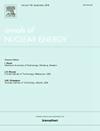Novel geopolymer materials for fast and thermal neutron shielding
IF 1.9
3区 工程技术
Q1 NUCLEAR SCIENCE & TECHNOLOGY
引用次数: 0
Abstract
In this work, we developed novel geopolymer (GP) composites for neutron shielding applications by dispersing up to 50 wt polyethylene (PE) and boron carbide (BC) powders into a potassium-based GP (KGP) matrix. We measured their attenuation coefficients to fast neutrons using a spontaneous fission 252Cf source and a fusion deuterium–tritium generator and to thermal neutrons using a moderated 252Cf source. The PE-based KGP were designed to reduce the neutron primary energy through neutron–hydrogen collisions, while 10B in BC was exploited to capture and stop thermal neutrons. The fast-neutron shielding properties of 50 wt PE-KGP were superior, with an attenuation coefficient to fission neutrons up to 30% higher than that of high-density concrete. The BC-based KGP formulation with BC at 25 wt and 50 wt outperforms commercial boron-loaded flexible materials by approximately 18% and 50%, respectively. In simulation, we combined KGP with PE and BC dispersants. A prototypical material comprised of 50 wt PE-KGP and 50 wt BC-KGP significantly outperformed barite in reducing the dose due to fission-based spectra, similar to those found at nuclear reactors. Additionally, KGP shows excellent adhesive properties, high-temperature resistance, and can be molded into any size or shape, as well as 3D or 4D printed. Therefore, PE and BC-loaded KGP and associated manufacturing techniques can be effectively employed in nuclear power plants and other facilities that rely on intense neutron sources, significantly enhancing their safety and cost-effectiveness.
求助全文
约1分钟内获得全文
求助全文
来源期刊

Annals of Nuclear Energy
工程技术-核科学技术
CiteScore
4.30
自引率
21.10%
发文量
632
审稿时长
7.3 months
期刊介绍:
Annals of Nuclear Energy provides an international medium for the communication of original research, ideas and developments in all areas of the field of nuclear energy science and technology. Its scope embraces nuclear fuel reserves, fuel cycles and cost, materials, processing, system and component technology (fission only), design and optimization, direct conversion of nuclear energy sources, environmental control, reactor physics, heat transfer and fluid dynamics, structural analysis, fuel management, future developments, nuclear fuel and safety, nuclear aerosol, neutron physics, computer technology (both software and hardware), risk assessment, radioactive waste disposal and reactor thermal hydraulics. Papers submitted to Annals need to demonstrate a clear link to nuclear power generation/nuclear engineering. Papers which deal with pure nuclear physics, pure health physics, imaging, or attenuation and shielding properties of concretes and various geological materials are not within the scope of the journal. Also, papers that deal with policy or economics are not within the scope of the journal.
 求助内容:
求助内容: 应助结果提醒方式:
应助结果提醒方式:


